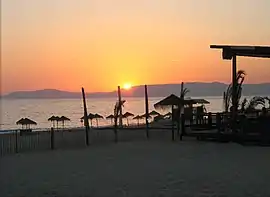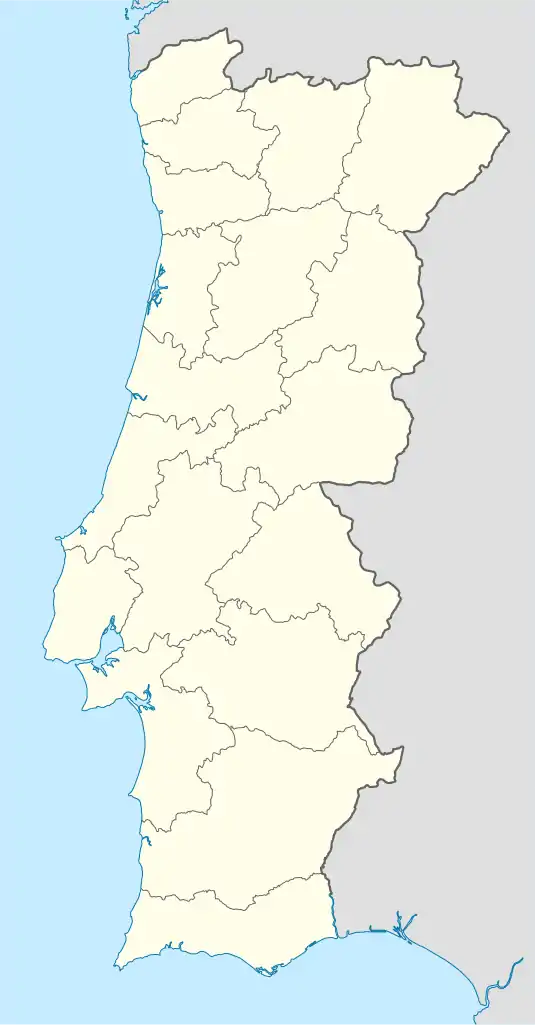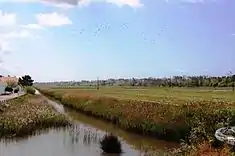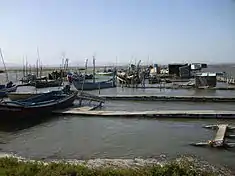Comporta (civil parish)
Comporta is a freguesia ("civil parish") and village in the municipality of Alcácer, in the old district of Setúbal, in continental Portugal, located at the base of Tróia Peninsula, along the Sado estuary. The population in 2011 was 1,268,[1] in an area of 150.54 km².[2] It is part of, and the namesake of, the larger Comporta Coast region.
Comporta | |
|---|---|
 The white sand beaches of Carresqueira, along the Sado estuary | |
 Comporta Location in Portugal | |
| Coordinates: 38.380°N 8.786°W | |
| Country | |
| Region | Alentejo |
| Intermunic. comm. | Alentejo Litoral |
| District | Setúbal |
| Municipality | Alcácer do Sal |
| Area | |
| • Total | 150.54 km2 (58.12 sq mi) |
| Elevation | 24 m (79 ft) |
| Population (2011) | |
| • Total | 1,268 |
| • Density | 8.4/km2 (22/sq mi) |
| Time zone | UTC±00:00 (WET) |
| • Summer (DST) | UTC+01:00 (WEST) |
| Postal code | 7580 |
| Area code | 265 |
| Patron | São Pedro |
History
During the time of the Companhia das Lezírias, Comporta was a small agglomeration of 65 impoverished cabanas around a principal estate.[3]
Until 1989, Comporta was a part of the parish of Santa Maria do Castelo.
Geography

Located along the peninsula of Tróia on the southern margin of the Sado River, the region is characterized by the number or rice fields under cultivation. In addition, its vicinity within the Sado estuary makes the region a focus of many species of terrestrial and marine birds, including the grey herons, storks and flamingos.
While Comporta is the administrative centre of the parish, there are several small population concentrations throughout (localities, places or villages); they include: Brejo da Carregueira, Brejo da Carregueira de Cima, Cambado, Comporta, Figueiral Moitinha, Murta, Possanco, Torre, Torroal and Carrasqueira.
Economy
The principal economic activities in the area include fishing, agriculture, small industry associated with rice harvesting for local and migrant workers, in addition to many tertiary services (hotels, bakeries, civil construction, sawmilling, carpentry and small commercial shops). Tourism has become an increasingly important part of this mix, with new investments into the area: the main village of Comporta has developed into an upmarket holiday destination, due to its tourist-friendly beaches and the number of restaurants and boutiques.[4]
Commercial rice cultivation was an important part of the economy since 1925, providing employment to many factories, although over the years these facilities have been closed and the management of the lands transferred to Lisbon or Ribatejo.[5] The "Comporta" brand, promoted by the Herdade da Comporta since 1925, gave way to new packaging under the Alcacer do Sal or Coruche brands.[5] The rice industry has become less an integral part of the community, and only the Arroz Ceifeira brand, managed by João Duarte Correia (an ex-miller in the Torrinha factory) continues to sell/promote the local industry.[5]
Architecture

Civic
- Residence of Estorno (Portuguese: Casa Tradicional da Carrasqueira/Casa de Estorno),[6] this type of home was divided into two spaces (a kitchen-dining area and bedroom) with dirt floors (the bedroom covered in wood-floors) and kiln in brick.
- Fountain of Abóbada (Portuguese: Fonte da Abóbada)
- Port of Carrasqueira (Portuguese: Porto de pesca palafítico da Carrasqueira),[7] located within the Sado Estuary Nature Reserve (Portuguese: Reseva Natural do Estuário do Sado) the artesnal fishing port, the Port of Carrasqueira is known for the wooden dock, built on stilts (a municipal heritage due to its method of construction, extension and important contribution to the local landscape), along with the Concheiros do Paleolítico.[8]
Religious
- Church of São Pedro (Portuguese: Igreja Paroquial da Comporta/Igreja de São Pedro)[9]
- Chapel of São Pedro (Portuguese: Capela de São Pedro)
Culture
Portuguese handicrafts, particularly miniatures boats of wood, quilts, needlework and embroidery are common in many of the villages.
Although the patron saint is Saint Peter, the residents of Comporta continue to celebrate other religious festivals associated with the popular saints, in addition to the Festival do Arroz (Rice Festival), which celebrates the founding of the parish. Every two years the village of Carrasqueira is the site of the Festival da Batata Doce (Sweet Potato Festival), as well as being the annual meeting-place for motorcyclists. On the second Friday of each month, there is a traditional market, in which the inhabitants sell handicrafts, food and other goods.
The major associations in the parish are the Clube Recreativo da Herdade da Comporta (Recreational Club of the Herdade da Comporta), the Grupo Desportivo da Carrasqueira (Sport Group of Carrasqueira), the Grupo Motard Rateres do Sado (Motorcycle Club of the Sado) and the Associação de Moradores dos Brejos (Residents Association of Brejos) .
In addition to the popular bolinhos de arroz (rice balls), the traditional culinary plate in Comporta is beans with rice and linguiça, in addition to the popular bacon and chouriço and coriander cooked in an earthen pot over woodfire, or the arroz de bacalhau (rice cod),[5] ensopado de enguias (eel soup/stew) and massa de peixe (fish pasta).[8]
See also
References
Notes
- Instituto Nacional de Estatística (INE), Census 2011 results according to the 2013 administrative division of Portugal
- "Áreas das freguesias, concelhos, distritos e país". Archived from the original on 2018-11-05. Retrieved 2018-11-05.
- Serpa Pimental et al. (1850), p.46-47
- Egan, Maura (23 July 2010), "Full Disclosure: Comporta, Portugal", New York Times Style Magazine, New York, New York: The New York Times Co., retrieved 16 March 2010
- Nara Leão (1 December 2008). "Comporta "PortàPorta"" [Comporta Door-to-Door] (in Portuguese). Comporta, Portugal: Mais Comporta. Retrieved 16 March 2011.
- Mestre, Victor; Costa, Patrícia (2007), SIPA (ed.), Casa Tradicional da Carrasqueira/Casa de Estorno (IPA.00025194/PT041501060057) (in Portuguese), Lisbon, Portugal: SIPA – Sistema de Informação para o Património Arquitectónico, retrieved 20 July 2013
- Belo, Albertina (1999), SIPA (ed.), Porto de pesca palafítico da Carrasqueira (IPA.00007027/PT041501060014) (in Portuguese), Lisbon, Portugal: SIPA – Sistema de Informação para o Património Arquitectónico, retrieved 20 July 2013
- Nara Leão (29 October 2008). "Comporta" (in Portuguese). Comporta, Portugal: Mais Comporta. Retrieved 16 March 2011.
- Belo, Albertina (1999), SIPA (ed.), Igreja Paroquial da Comporta/Igreja de São Pedro (IPA.00006635/PT041505050039) (in Portuguese), Lisbon, Portugal: SIPA – Sistema de Informação para o Património Arquitectónico, retrieved 10 April 2017